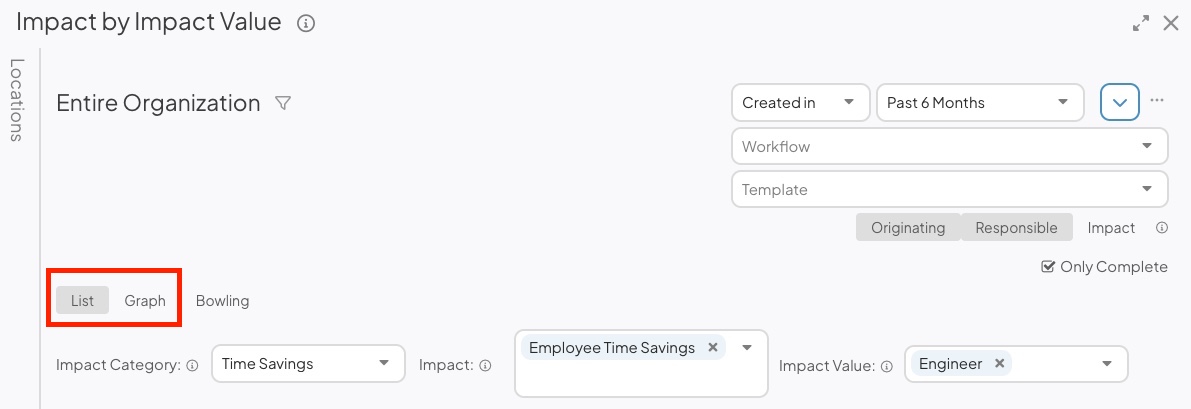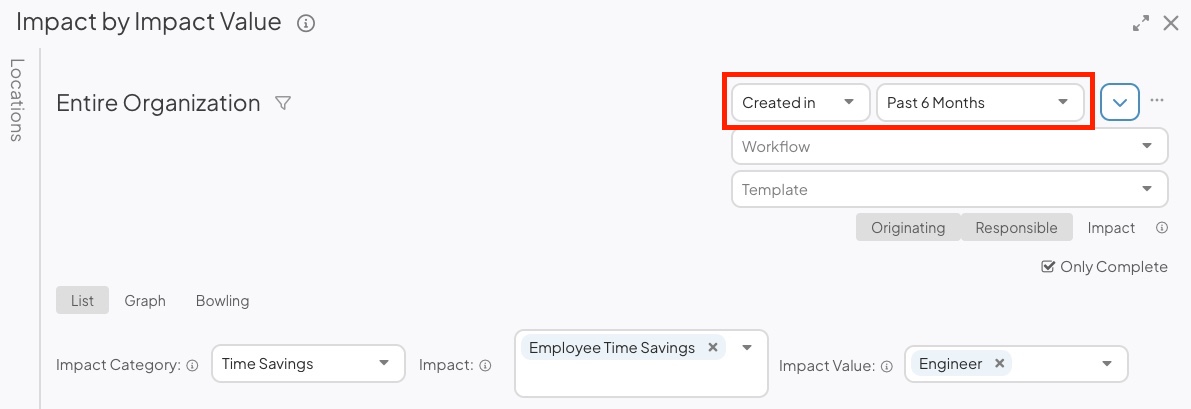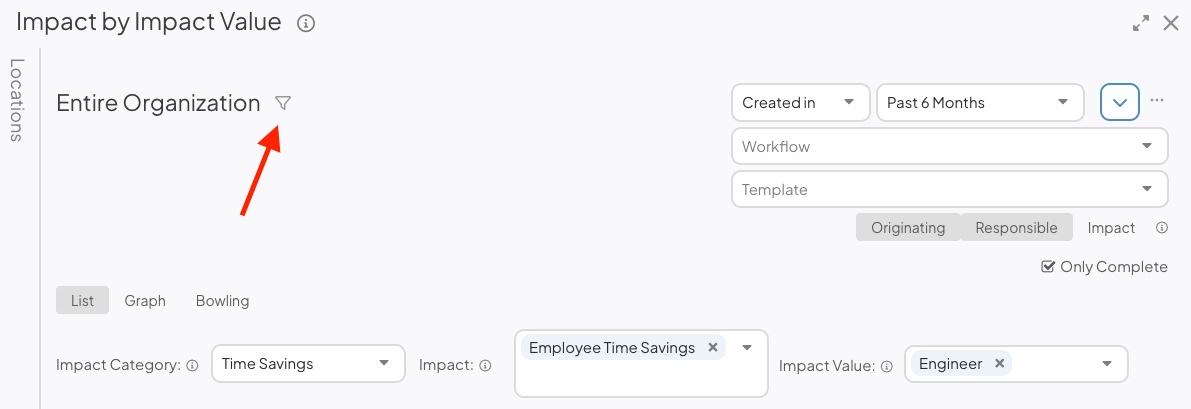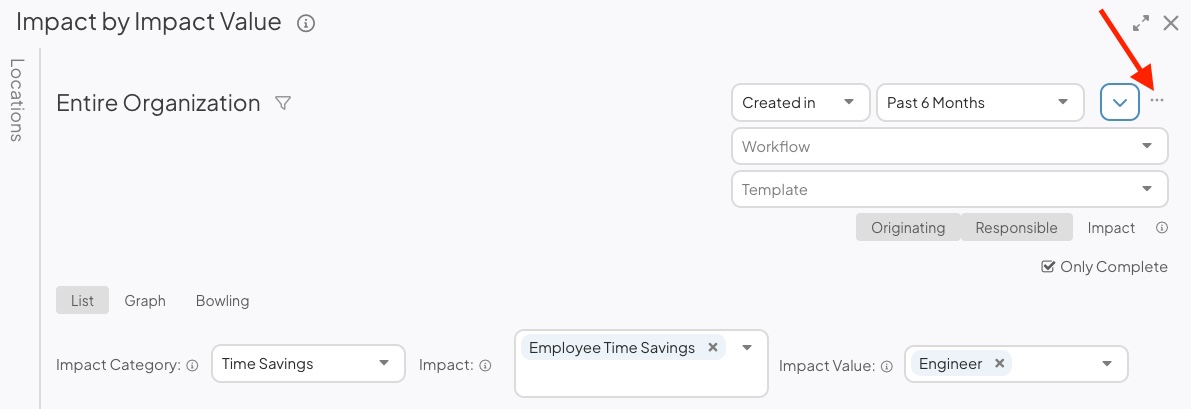Impact by Impact Value Report
Track and analyze individual Impact Values
The Impact by Impact Value Report allows you to track individual Impact Values, making it a great tool for organizations that assign multiple Impact Values within an Impact Type.
What is an Impact Value?
To utilize the Impact by Impact Value Report, it is important to understand what an Impact Value is. In short, an Impact Value is an additional classification within an Impact Type.
For example, your organization might have an Impact Type of “Decreased Gas Emissions” within the Impact Category of Environmental Impact. If you want to track different forms of gas emissions, then you can add Impact Values of CO2 and Methane within the Impact Type. Now whenever you log a “Decreased Gas Emissions” Impact, you can also specify whether it was for CO2 or Methane gas. When reporting on Environmental Impact, you could then use the Impact by Impact Value Report to view the CO2 and Methane Impact separately instead of having them grouped together under the same Impact Type.
The Impact by Impact Value Report could look like the example below:

Who can access the Report?
Anyone with the “View Report Data” and “View Impact” permissions can view the Impact by Impact Value Report.
This Report can be accessed under the Impact section of the Reports page. It can also be added as a Card on a Board.
How to use the Impact by Impact Value Report
- Select what Impact you want to report on
- Choose the Report view
- Apply Filters to control what data is displayed on the Report
- View a List of Items referenced by the Report
- Share the Report
Select which Impact you want to report on
The Impact by Impact Value Report allows you to view data for one Impact Category at a time. To specify what Impact you want to report on, use the Impact Category, Impact, and Impact Value dropdowns to customize the data appearing on your Report.

- Impact Category: Use the dropdown to select which Impact Category you would like to report on.
- Impact: Use the dropdown to select which Impact Types within the selected category you would like to report on.
- If no Impact Types are selected, then all Impact Values within the Impact Category will appear on the Report.
- Impact Value: Use the dropdown to specify which Impact Values you would like to report on.
- If no Impact Values are selected, all Impact Values within the selected Impact Types will appear on the Report.
/Ofie/Ofie%20Profile%20Pic.png?width=50&height=50&name=Ofie%20Profile%20Pic.png) Ofie Tip: Only categories that have at least one Impact with Impact Values under them will appear in the Impact Category dropdown.
Ofie Tip: Only categories that have at least one Impact with Impact Values under them will appear in the Impact Category dropdown.
Choose the Report view
If your organization is not using the Advanced ROI module, the Report will have two views: List and Graph. To toggle between them, select the name of the view you want to see.

- List view displays the Total, One-Time, and Recurring Impact for each Impact Value. By default, the columns will be organized into a Currency section for Impacts with monetary units and Values section for Impacts with non-monetary units. Data will populate the appropriate column based on the unit in which the Impact was logged. Hover over the header of any column, and select the caret icon on the right to customize the List view columns.
- Sort Ascending will arrange the data from low to high Impact based on the column you selected.
- Sort Descending will arrange the data from high to low Impact based on the column you selected.
- Columns will open an additional dropdown menu where you can customize which columns appear on the report.
- The Impact Value checkbox will be selected by default. Unchecking this box will remove the Impact Value column from the Report.
- Organizations with the Advanced ROI module will have options to report on Target and Forecast Impact in addition to Actual Impact.
- Graph view displays data as a bar graph.
- Display as Bar: Expand the drop-down to select which dataset the bars on the graph should represent. By default, the Report will show the Total Actual Impact in currency.
- Display as Line: Expand the drop-down to select which dataset the line on the graph should represent. By default, there will be no selection.
- Sort: Expand the drop-down to select by which criterion the dataset should be ordered.
- Max: Enter the number of data points that should be represented on the graph. By default, the Report will show 15 data points, but it can be configured to show 1-53.
- Show Values: When enabled, the value of each data point will be displayed on the graph.
- You can also view the value of each data point in Graph view by hovering over the bar or point on the line.
/Ofie/Ofie%20Profile%20Pic.png?width=50&height=50&name=Ofie%20Profile%20Pic.png) Pro Tip: Are you unsure what all the options in the Display as Bar and Display as Line drop-downs mean? Check out this article to learn more about important Impact terminology.
Pro Tip: Are you unsure what all the options in the Display as Bar and Display as Line drop-downs mean? Check out this article to learn more about important Impact terminology.
If your organization uses the Advanced ROI module, this Report will have a third view called Bowling view.

- Bowling view displays each Impact Value’s Actual, Target, and Forecast Impact as a bowling chart, color-coding the Actual impact based on how it compares to the Target or Forecast Impact.
- Show: Select any combination of Target, Forecast, Actual, Current Forecast, and Actual Variance to add or remove them from the report.
- By default, Target, Actual, and Forecast Impact will be selected.
- Show: Select any combination of Target, Forecast, Actual, Current Forecast, and Actual Variance to add or remove them from the report.
-
-
- Current Forecast displays the Actual Impact for past time intervals and the Forecast Impact for present and future time intervals. This gives you a dynamic outlook on Impact that considers the current date.
- Actual Variance displays the difference between the Actual Impact and Target or Forecast Impact, depending on which is selected as the reference. This helps you see how much the Actual Impact differs from prior estimates.
- Reference: Pick which data series you want the Actual Impact to reference when color-coding the chart. You can select Target, Forecast, or None.
- Selecting None will result in a chart that is not color-coded.
- The Column Totals checkbox: When selected, you will see a footer at the bottom of the Report that summates the data in each time interval.
- The Row Totals checkbox: When selected, you will see an additional "Total" column on the left of the time intervals that summates data in each row.
- The Future Color checkbox: When selected, time intervals in the future will be color-coded according to whether the Actual Impact is greater or lesser than the referenced Impact.
- This checkbox is unselected by default, so future intervals will not show false results due to Actual Impact not being logged yet.
-
Display As: Choose Currency or Unit to control how Impacts are shown in the Report.
- Currency: Shows the financial value of the Impacts.
- Unit: Displays the quantity of Impacts recorded in non-financial units. For example, Time Savings Impacts would be shown in hours.
- If you select this option, we recommend filtering the Report to include either a single Impact Type or Impact Types that use the same unit. This ensures the results are meaningful and prevents mixing different units in the same Report.
-
Apply Filters to control what data is included in the Report
Any relevant Filters active on the main Reports screen will automatically be applied, but you can add additional Filters to customize what data is included in the Report.
- There are two date-based drop-downs that will filter the Report for data within a specified time frame.

- Reference Date: Expand the drop-down to choose which type of date should be referenced by the Report. For example, select “Created in” if you want the Report to reference only Items that were created in the specified date range.
- Range: Expand the drop-down to choose the range of dates that should be included in the Report.
- All Time removes any date range parameters.
- Custom allows you to enter any date range you want.
- Past shows you a rolling date range that counts back from the current calendar date.
- Current shows you data for the current week, month, quarter, or year.
- Last shows you data for the previous week, month, quarter, year, or multi-year period.
/Ofie/Ofie%20Profile%20Pic.png?width=50&height=50&name=Ofie%20Profile%20Pic.png) Pro Tip: The Last YTD option helps you set a date range matching the current year-to-date period but for the previous year instead. For example, if it is March 15th, 2024, and you select Last YTD, your Report will cover data from January 1st, 2023, to March 15th, 2023. This logic is also true for the Last MTD and QTD options.
Pro Tip: The Last YTD option helps you set a date range matching the current year-to-date period but for the previous year instead. For example, if it is March 15th, 2024, and you select Last YTD, your Report will cover data from January 1st, 2023, to March 15th, 2023. This logic is also true for the Last MTD and QTD options.
-
- Bowling view includes an additional option for Interval. Expand the dropdown to choose which intervals, or “buckets,” the Report should be organized by.
- Workflow: Expand the drop-down to choose which Workflows should be included in the Report.
- Template: Expand the drop-down to choose which Templates should be included in the Report.
- Select Originating, Responsible, or Impact to decide whether the Report should reference Items from the Originating, Responsible, or Impact Location.
- Originating and Responsible will be the default selection.
- If Impact is selected, both Originating and Responsible will be toggled off.
- If no Location is selected in the Location Picker or Item Filter, the Originating, Responsible, and Impact toggles will not affect Report data.
- The Only Complete checkbox: When enabled, the Report will only include data from completed Items; when disabled, it includes data from any Item that has a Resolution saved, regardless of status.

- Currency: This option is only available if your organization has multiple currencies enabled. By default, the Report will only show the financial Impact of Items using your Location's default currency. To change the Report's currency, expand the Currency drop-down and select the desired currency.
- Currency Conversion: Currency conversion is only available if your organization has multiple currencies and the Advanced ROI Module. When currency conversion is enabled, there will be two currency drop-downs.

- Reported in: This drop-down determines which Impacts are included in the Report based on their original currency. When a currency is selected, the Report will include all Impacts logged in that currency. For example, if a project's Impact was recorded in USD, then USD must be included in this field for the project's data to appear in the Report.
- This drop-down is multi-select. If you want to consider all Impacts in your organization regardless of their currency, then select all options or choose Any Currency.
- By default, your Location's default currency will be listed.
- Display As: This drop-down determines which currency the Report displays. All Impacts that match your filters will be converted to the currency selected. For example, if you choose USD and EUR in the "Reported in" drop-down and then you display the data as EUR, the system will convert USD Impacts to EUR and display all data as EUR.
- This drop-down is single-select. The Report can only display data in one currency at a time.
- By default, your Location's default currency will be selected.
- Reported in: This drop-down determines which Impacts are included in the Report based on their original currency. When a currency is selected, the Report will include all Impacts logged in that currency. For example, if a project's Impact was recorded in USD, then USD must be included in this field for the project's data to appear in the Report.
/Ofie/Ofie%20Profile%20Pic.png?width=50&height=50&name=Ofie%20Profile%20Pic.png) Pro Tip: The system will use your selection in the Reference Date drop-down when determining which Exchange Rate to use for the currency conversion. For example, if you select "Realized In," the Impacts are converted using the Exchange Rate active on their Realized Date. If you select "Created In," Impacts are converted using the Exchange Rate active during their Item's Create Date. Check out our article about setting your organization's Exchange Rates to view current and historical Exchange Rates configured by your organization.
Pro Tip: The system will use your selection in the Reference Date drop-down when determining which Exchange Rate to use for the currency conversion. For example, if you select "Realized In," the Impacts are converted using the Exchange Rate active on their Realized Date. If you select "Created In," Impacts are converted using the Exchange Rate active during their Item's Create Date. Check out our article about setting your organization's Exchange Rates to view current and historical Exchange Rates configured by your organization.
- Select the filter icon to open the Item Filter window.

- Update the Item Filters to control which Items are included in the Report’s metrics. For example, you could reference only the Items in specific Statuses.
- Click Save.
- Select the arrow on the Location Filter on the left side of the Report to expand it.
- Filter the Report by Location to view the data for specific Locations within your organization.
View a List of Items referenced by the Report
You must be in List or Graph view to see a List of Items referenced by the Report.
When in the List view:
- Select the numerical or monetary value of any Impact Value to see a List of all Items contributing to that metric.
When in the Graph view:
- Select a bar or point on a line to see a List of all Items contributing to that metric.
Share the Report
To share the Report, select the ellipsis icon. In the resulting drop-down menu, you can export the Report as a PDF, download it as an XLSX file, or copy it to a Board.

- Select Print/Save PDF to export the Report as a PDF. The "Print" window will open.
- Page Size: Expand the drop-down to choose your preferred page size.
- Scale: Expand the drop-down to choose the scale percentage. This allows you to fit more content on a single page. For example, selecting 50% doubles the amount of content you can fit on one page. Make sure to select "Fit to page" in your browser's print settings.
- Click either Portrait or Landscape to choose the PDF's orientation.
- Click Print.
/Ofie/Ofie%20Profile%20Pic.png?width=50&height=50&name=Ofie%20Profile%20Pic.png) The Location of the Report will appear on the exported PDF beneath the Report title.
The Location of the Report will appear on the exported PDF beneath the Report title.
- Select Save XLSX to export the Report as a spreadsheet document.
- This option is only available in the List view.
- Only visualized columns will be included in the export.
- Select Copy to Board to add the Report as a Card on a Board.
- In the resulting window, select a Board. All Boards that you have permission to edit will appear as options.
- Select Copy to add the Report to your selected Board. All filters and columns included on the Report will be carried over to the Card.
- The Report Card will appear at the Board's top left corner.
Impact by Impact Value Report Cards
Impact by Impact Value Reports can also be added as a Card on Boards.
When creating an Impact by Impact Value Report Card, you use the same filters discussed in this article to build the Report. However, you will have an additional Sort option when the Report is in List view.

- Sort: Use the drop-down to decide by which criteria the Report should be ordered. For example, sorting by Units-Total-Actual will result in a list where the Impact Value with the most greatest amount of units logged in Item Resolutions will be listed first.